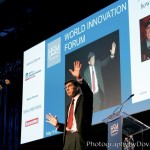May12
Job-Focused Innovation
Point: When innovating, look at the “job” the customer hires a product to do

Story: At the World Innovation Forum, Clayton Christensen cautioned companies against focusing only on customers when they create incremental innovations. Instead, he recommended understanding the job that the product is hired to do by those customers.
To illustrate the “product’s job” concept, Christensen described a fast food chain’s milkshake sales. At the demographic level, many milkshake buyers are working-age people. But the demographic similarity is not what drives people to buy milkshakes. (When the company researched demographically similar people, the results did not improve sales.) In fact, a focus on age and gender missed the job that milkshakes perform — why do people “hire” (buy) the milkshake? What job do they want the milkshake to perform?
Through further research, the fast food chain found that about half of milkshake sales occurred in the morning. These buyers came into the restaurant by themselves, bought a milkshake and nothing else, and drove away with the milkshake rather than consuming it at the restaurant. Looking deeper, researchers learned that the buyers were commuters, and the job of the milkshake was to provide distraction on a long commute and to tide them over until lunch. For this job, the milkshake competed with bananas, donuts, breakfast bars, and coffee. Commuters hired milkshakes over the competition because milkshakes take a long time to eat, don’t slosh or leave crumbs, and can be held in one hand or be put into a cupholder during the drive.
A very different group of milkshake buyers came in the afternoon and evening. These buyers were predominately dads with little kids. The dads were buying milkshakes for an entirely different job: that of assuaging guilt over not having enough time with their kids. Kids liked the milkshakes, and the dads could finally say “yes” to something and feel good about themselves.
Understanding the jobs people hire milkshakes to do is important when it comes to incremental product improvements. The two jobs for milkshakes call for diametrically different innovations. Thicker milkshakes would delight the bored commuter, but they would frustrate time-pressed dads because kids take too long to finish thicker shakes.
Simply put, innovations that would boost sales in one group would displease the other group. Commuters might want improvements like increased thickness, small added fruit chunks, and a grab-and-go purchase system that lets customers buy a milkshake without standing in the regular food line. In contrast, dads might want a smaller, thinner milkshake that provides fun but quick treat for the kids. The strategy for innovation in this case may be to have two different shake formulations: one for the morning and one for the afternoon/evening.
The point is to understand WHY someone buys the product, not WHO buys the product. The demographics of milkshake buyers are less important than the fact that one segment buys the product as a distraction and protracted meal while the other buys it as a sweet attraction and quick desert.
Action
- Delve into the job(s) of the product, not the consumer(s) of the product.
- Segment by purpose, not person.
- Identify and innovate around job performance dimensions rather than product performance dimensions
1 Comment »Entrepreneurs, How-to, Innovation, New Product Development, Opportunity, Strategy











